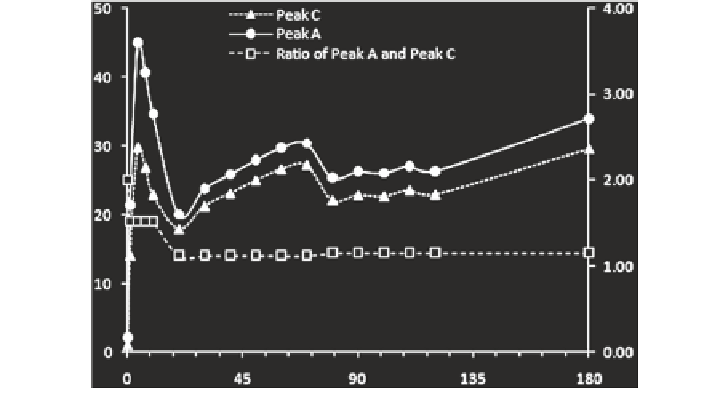Environmental Engineering Reference
In-Depth Information
Incubation time (days)
Fig. 6
The changes in the fluorescence intensities of peaks A and C and their fluorescence inten-
sities ratios of autochthonous fulvic acid (C-like) originated under microbial assimilations of lake
algal biomass during the long-term dark incubation period (1-180 days). The fluorescence inten-
sities of both peaks A and C are the average of duplicate samples.
Data source
Mostofa KMG et
al. (unpublished data)
ratio becomes high (peak A/peak C
=
1.53) from 1 to 10 days, then it decreases to
0.98 from 20 to 70 days, and decreases again to 0.87 between 80 and 180 days of
incubation (Table
3
; Fig.
6
). It is in agreement with earlier results concerning the
production of CDOM in resuspension of particulate matter in an isotonic solution
(0.5 ‰ salinity, no N and P). The measured spectral slope S
300-500
was highest at
the 6th day, reached the lowest level at the 9th day, increased during days 12-18
and after 21 days it remained approximately constant (Zhang et al.
2009a
). Time-
scale variation in the release of new DOM depends on the several key factors
such as contents of nutrients, occurrence of microorganisms, salinity, and nature
of particulate materials. Microbial degradation can also increase the spectral slope
S
350
-
S
400
(nm
−
1
), which is an index of high molecular weight substances and
can decrease
S
275
-
S
295
(nm
−
1
), which is related to low molecular weight DOM
(Helms et al.
2008
).
The reported findings allow three characteristic phenomena to be hypothesized
for the microbial degradation of autochthonous fulvic acid (C-like) of algal origin.
Firstly, autochthonous fulvic acid (C-like) is primarily released in the initial phase
(4-6 days), and afterward the fluorophores bound at peaks A- and C-regions may be
rapidly decomposed by microbial processes (4-20 days). The result is the decrease
either in the fluorescence intensities of both peaks A- and C-regions of autoch-
thonous fulvic acid (C-like) or in the overall absorbance properties of CDOM.
Secondly, the fluorophores connected to the peak A-region of autochthonous ful-
vic acid (C-like) may undergo faster microbial decomposition compared to those

